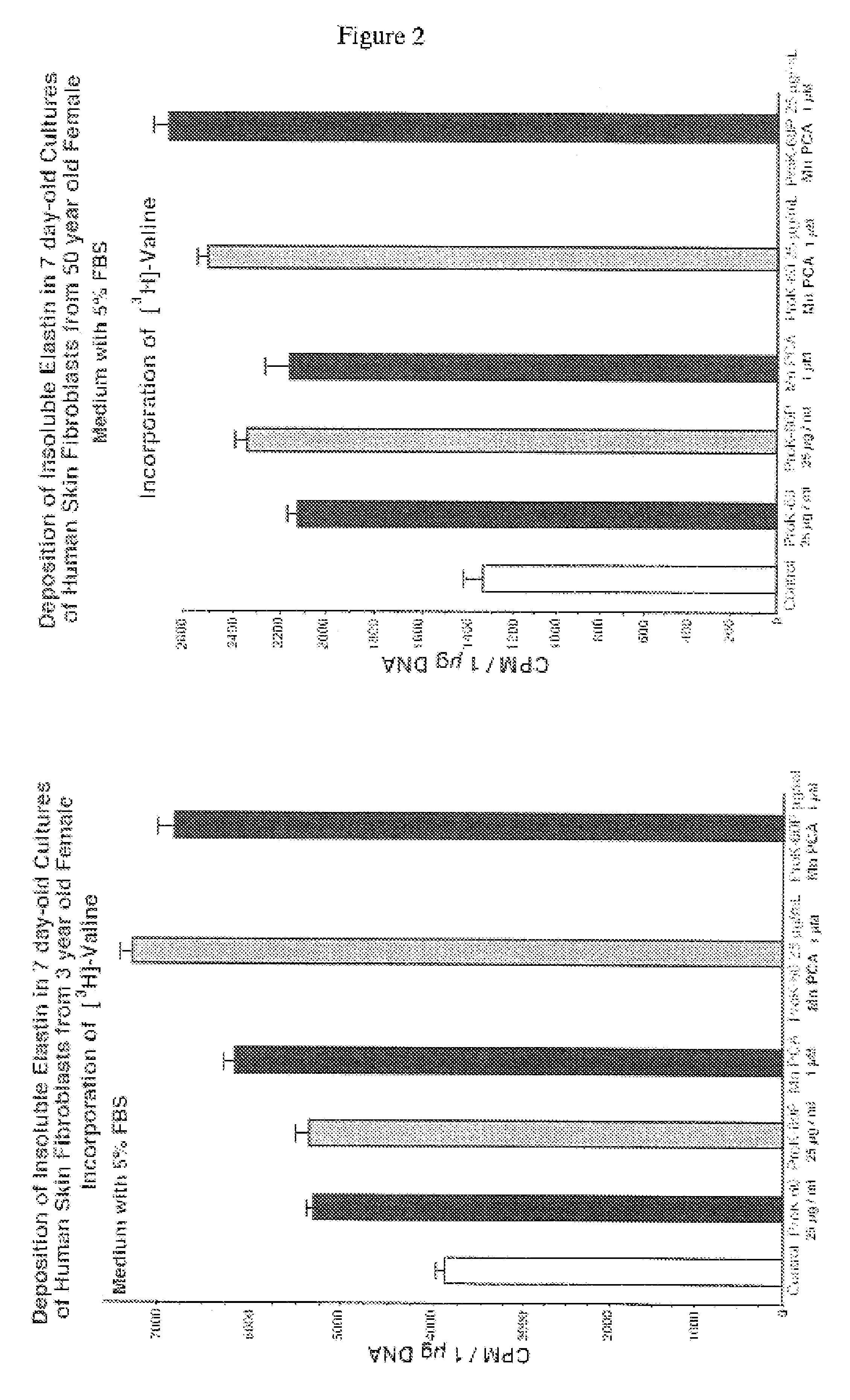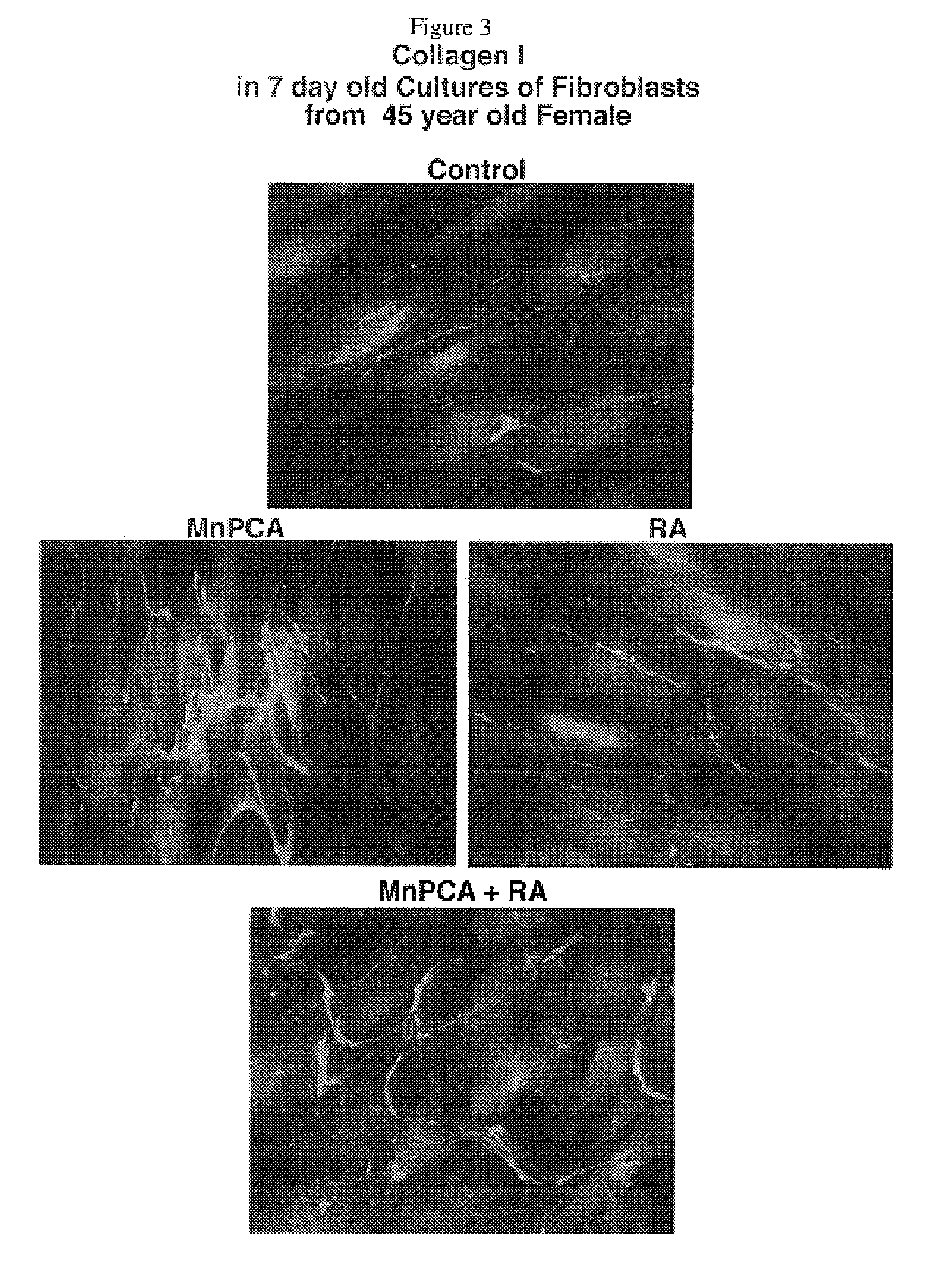Compositions for elastogenesis and connective tissue treatment
a technology of elastogenesis and connective tissue, applied in the direction of drug compositions, antinoxious agents, peptide/protein ingredients, etc., can solve the problems of local collapse of elasticity, severe loss of elasticity, and inability to be quickly replaced by local, so as to stimulate the production of insoluble elastin, and improve the elasticity or appearance of said tissu
- Summary
- Abstract
- Description
- Claims
- Application Information
AI Technical Summary
Benefits of technology
Problems solved by technology
Method used
Image
Examples
example 1
[0113]Materials and Methods. The following materials and methods apply to Examples 1-6 herein. Manganese-PCA (Mn-PCA) from DD Chemco, Irvine Calif. was used in the following Examples 1-6. The ProK formulations are elastin peptide digests available from Human Matrix Science, LLC. Biological effects of the preparations of the following Examples were tested in cultures of skin fibroblasts derived from healthy caucasian females of different ages: Females of the ages of 50 years old (code 2-4), 26 years old (code 9063) and 3 years old (code 4184) were used. All of these fibroblasts were originally isolated by digestion of skin biopsies with mixture of 0.25% collagenase type I (Sigma) and 0.05% DNAse type I (Sigma) and then passaged by trypsinization and maintained in alpha-minimum essential medium supplemented with 20 mM Hepes, 1% antibiotics / antimycotics, 1% L-Glutamate and 5% fetal bovine serum (FBS). In all experiments of Examples 1-6, the consecutive passages 3-7 were tested. In some...
example 2
[0117]Mn-PCA in combination with ProK-60 and ProK-60P. Refer to FIG. 2, which illustrates the deposition of insoluble elastin in human skin fibroblasts from the 3 year old female and the 50 year old female. After metabolic labeling with [3H]-valine, the newly synthesized insoluble elastin in fibroblast cultures stimulated with Mn-PCA and Mn-PCA / ProK-60, Mn-PCA / ProK-60P combinations showed increased deposition of cross-linked elastin (insoluble elastin). The fibroblasts from the 3 year old and 50 year old subjects were tested.
example 3
[0118]Mn-PCA in combination with Retinoic Acid. Immunohistochemical analysis of collagen type I in human dermal fibroblast cultures stimulated with Mn-PCA and Mn-PCA / Retinoic Acid combination revealed an increased deposition in collagen type I. Refer to FIG. 3, which illustrates the immunohistochemical analysis of collagen type I levels in human dermal fibroblasts. By comparison to the control it is seen that collagen production was stimulated by Mn-CPA alone and Mn-CPA in combination with retinoic acid.
PUM
| Property | Measurement | Unit |
|---|---|---|
| molecular weight | aaaaa | aaaaa |
| thickness | aaaaa | aaaaa |
| thickness | aaaaa | aaaaa |
Abstract
Description
Claims
Application Information
 Login to View More
Login to View More - R&D
- Intellectual Property
- Life Sciences
- Materials
- Tech Scout
- Unparalleled Data Quality
- Higher Quality Content
- 60% Fewer Hallucinations
Browse by: Latest US Patents, China's latest patents, Technical Efficacy Thesaurus, Application Domain, Technology Topic, Popular Technical Reports.
© 2025 PatSnap. All rights reserved.Legal|Privacy policy|Modern Slavery Act Transparency Statement|Sitemap|About US| Contact US: help@patsnap.com



